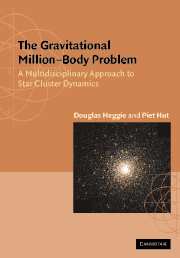Book contents
- Frontmatter
- Contents
- Preface
- PART I INTRODUCTIONS
- PART II THE CONTINUUM LIMIT: N → ∞
- PART III MEAN FIELD DYNAMICS: N = 106
- PART IV MICROPHYSICS: N = 2
- 13 Exponential Orbit Instability
- 14 Two-Body Relaxation
- 15 From Kepler to Kustaanheimo
- PART V GRAVOTHERMODYNAMICS: N = 106
- PART VI GRAVITATIONAL SCATTERING: N = 3
- PART VII PRIMORDIAL BINARIES: N = 4
- PART VIII POST-COLLAPSE EVOLUTION: N = 106
- PART IX STAR CLUSTER ECOLOGY
- Appendix A A Simple N-Body Integrator
- Appendix B Hints to Solution of Problems
- References
- Index
15 - From Kepler to Kustaanheimo
Published online by Cambridge University Press: 05 June 2012
- Frontmatter
- Contents
- Preface
- PART I INTRODUCTIONS
- PART II THE CONTINUUM LIMIT: N → ∞
- PART III MEAN FIELD DYNAMICS: N = 106
- PART IV MICROPHYSICS: N = 2
- 13 Exponential Orbit Instability
- 14 Two-Body Relaxation
- 15 From Kepler to Kustaanheimo
- PART V GRAVOTHERMODYNAMICS: N = 106
- PART VI GRAVITATIONAL SCATTERING: N = 3
- PART VII PRIMORDIAL BINARIES: N = 4
- PART VIII POST-COLLAPSE EVOLUTION: N = 106
- PART IX STAR CLUSTER ECOLOGY
- Appendix A A Simple N-Body Integrator
- Appendix B Hints to Solution of Problems
- References
- Index
Summary
The previous chapter was concerned with the consequences of two-body interactions, but made use of nothing more than an approximate solution of the two-body problem. Here we consider the classical two-body problem without approximations. It is one of the oldest solved problems of dynamics, and so, as we mentioned in the preface, it is no longer really a problem. Yet its structure is of enduring interest, and offers new surprises each time we view it from a fresh angle.
Along with the simple harmonic oscillator, the Kepler problem is to dynamics what the Platonic solids are to geometry. And, just as there is a duality among the latter (for example the cube, with six faces and eight vertices, is dual to the octahedron, with six vertices and eight faces), we shall see that there is an intimate link between these two dynamical problems. This chapter may look self-indulgent compared with the serious issues of stellar dynamics in the surrounding chapters, and should perhaps be in a box of its own, but in fact some of the results we shall survey have important applications to the million-body problem. The reason is that we shall be taking a close look at the singularity of the two-body equations, where numerical methods cause a lot of trouble.
Removing the collision singularity
Consider first the one-dimensional Kepler problem. With a suitable scaling, the equation of motion is
This equation is singular, corresponding to a collision in the Kepler problem.
- Type
- Chapter
- Information
- The Gravitational Million–Body ProblemA Multidisciplinary Approach to Star Cluster Dynamics, pp. 143 - 152Publisher: Cambridge University PressPrint publication year: 2003



